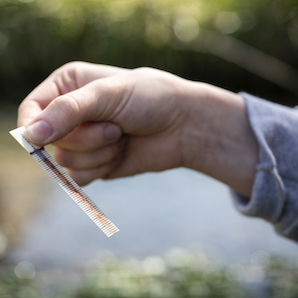Road salt has been touted as a lifesaver when it comes to combatting icy roads. Yet using this snow-melting mineral has a dark side once it enters waterways. Graduating senior Maggie Walker, through the Smithsonian-Mason School of Conservation (SMSC), is gathering data at local streams to influence change.
“When excessive road salts get into streams, they can have devastating effects on the ecosystems in the streams,” said Julia Sargent, director of programs at Friends of the North Fork of the Shenandoah River. “The salts impact vegetation and very small river life, and that in turn can have effects on larger life, like fish, and in high concentrations, those salts may not be filtered out by our water treatment plants.”

The Impact of Road Salts
Chloride pollution, which mainly comes from road salt, can also lead to corrosion, changed soil compositions, fish die-offs, algae blooms, and more, said Walker, who is partnering with Sargent’s organization for her SMSC practicum. “For people that need to be on low salt diets, they can actually exceed their daily salt requirement just from their drinking water, so that can end up being a health concern.”
Walker’s research is assessing the scope and impact of road salts locally.
Walker, an Honors College student studying biology, selected four streams near urban land cover, including sidewalks, parking lots, and cities, that are likely to be vulnerable to chloride pollution. For five weeks this semester, she has been heading to those streams to record the water temperature and collecting samples of stream water to measure chloride levels.
“It’s important that we establish what are the baseline levels of chloride in our waterways,” Walker said. “That way we can test it throughout the years, throughout the seasons, see when levels fluctuate, when they’re highest, how road salting events impact the water quality.”

Engaging the Community
There’s also a community aspect to the project that Sargent said Walker helped inspire.
“I’m creating a survey about people’s attitudes and behaviors toward road salt and road salt usage,” said Walker, which aligns with her interest in the intersection of conservation, human well-being, and community involvement. “We’re hoping to disseminate it to people who live in the North Fork… and then ultimately, using the data, determine one behavior to target for change.”
Though changing behavior and reducing road salt usage is outside the scope of this semester, Walker said the research is an important first step.
Walker, who is originally from Lancaster, Pennsylvania, said she chose George Mason University because she wanted to attend a school with excellent research opportunities, like SMSC.
“Getting to hear from and work with so many different conservation professionals is really inspiring,” Walker said, adding that they actively engage with students.
It’s rewarding for mentors, too.
“It’s been inspiring to get to know and work with these young people who are just getting their start along their career paths in conservation,” Sargent said. “Seeing their passions and being a part of that process is a big honor.”
SMSC is not an opportunity to pass up.
“If you are even remotely interested in conservation, you should definitely make every effort you can to come out and enjoy SMSC,” Walker said. “It really sets you up for success in conservation [by] introducing you to all the opportunities and allows you to explore things while you’re still in college.”
“If you’re a conservation-minded person, this is definitely the place to be.”

